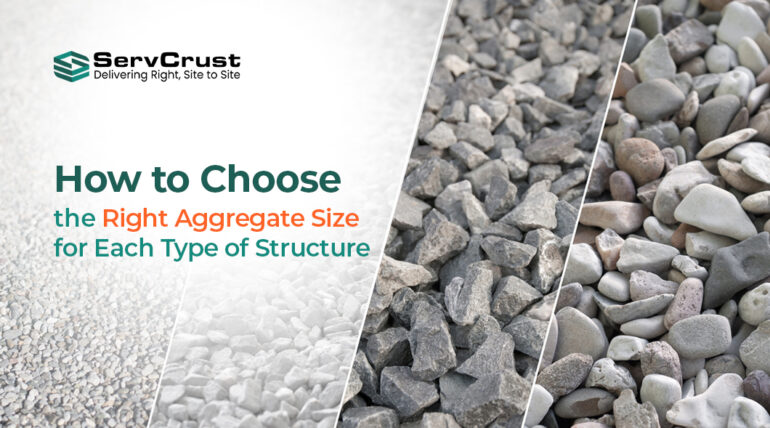
Choosing the right stone aggregate size for construction isn’t just a technical detail it directly impacts the strength, cost, and durability of a building. Whether you’re laying a foundation, casting an RCC slab, or preparing a road base, the size of the stone you use plays a major role in performance and longevity.
In this guide, you will get to know the most commonly used aggregate sizes: 10mm, 20mm, 40mm, and 60mm, and help you match each one to the right type of structure with real-life use cases. This will help you make more confident decisions whether you’re a contractor, site engineer, or house owner.
What Are Stone Aggregates in Construction?
Stone aggregates are crushed stones used as raw material in concrete, roads, foundations, and base layers.
Types of Stone Aggregates:
Coarse Aggregates: Large-sized stones like 20mm, 40mm, and 60mm.
Fine Aggregates: Small particles like sand or stone dust (used for finishing and bonding).
Aggregates improve strength, reduce shrinkage, and ensure bonding between cement and other components in concrete.
Common Aggregate Sizes in India
10mm – Light RCC work, flooring, plaster backfill
20mm – Standard for RCC slabs and beams
40mm – Foundations, road base layers
60mm – Road sub-base, drainage layers
Why Aggregate Size Matters in Structural Construction
Choosing the wrong aggregate size can lead to weak bonding, poor compaction, or even structural failure.
Factors to Consider:
- Type of structure: Load-bearing vs non-load bearing
- Reinforcement spacing: Smaller aggregates are better for closely spaced rebar
- Workability: Finer aggregates offer smoother mixing
- Cost & availability: Local supply affects final cost check with low-cost aggregate suppliers in your area
Best StoneAggregate Size for Strong Foundation
Recommended size: 40mm or 20mm
For most residential foundations, 40mm aggregate is ideal. It’s strong, economical, and helps reduce voids in mass concrete. For compact areas or detailed formwork, 20mm is more manageable.
Example:
An independent house with open footings often uses 40mm
A commercial building with pile foundations may use 20mm for better workability.
Use building foundation aggregates from trusted sources to ensure durability.
Ideal Aggregate Size for RCC
Recommended size: 20mm
RCC (Reinforced Cement Concrete) used in slabs, beams, and columns performs best with 20mm stone aggregate. It balances strength and flow, making it suitable for dense rebar placement.
When to use 10mm:
Thin slabs or intricate reinforcement designs
Architectural elements like sunshades and window lintels
10mm vs 20mm aggregate:
10mm offers smoother finish but increases cement consumption
20mm is cost-effective for larger pours with good compaction
Suitable Aggregate Size for Road Work
Base layer: 40mm or 60mm
Surface layer: 20mm or less
The base needs large aggregates (like 60mm) to support weight and drain water. The surface layer should have smaller aggregates (like 20mm) for a smoother ride. In highway or rural road construction, 60mm aggregates are often used as a sub-base for durability.
Choosing the Right Stone Size for Paver Base
For outdoor paving (like driveways or footpaths), proper layering is key:
Base layer: 40mm aggregate or crushed stone dust
Top layer: 10mm aggregate or M-Sand for smooth finish
Permeability is also important to avoid water stagnation. Using well-graded stones helps reduce maintenance later.
Where to Buy the Right Stone Aggregates Online
Servcrust is your trusted construction materials platform, you can easily buy 10mm, 12mm, 20mm, 40mm, and 60mm aggregates online through WhatsApp in simple message and get delivered within 24hours.
Why Choose ServCrust?
ServCrust offers 24-hour delivery across Telangana and Andhra Pradesh
Quality-checked materials, accurate sizing, and best price.
Easy online ordering for builders, contractors, and house owners
How to Check If Aggregate Size is Right for Your Structure
Here are some simple field tips to ensure you’re using the right stone size:
Workability Check: Mix and pour a small trial batch
Void Ratio Estimation: Ensure minimal air gaps for better bonding
Engineer Review: Always confirm with your site engineer or structural consultant
Conclusion
Choosing the right stone aggregate size for construction depends on the type of structure, reinforcement spacing, and the function of each layer. Choosing the correct size whether it’s 10mm for a thin slab, 20mm for RCC, 40mm for foundations, or 60mm for roads ensures durability, safety, and cost-efficiency.
Need stone aggregates delivered fast? Contact ServCrust your trusted partner for 10mm to 60mm stone aggregates in Telangana and Andhra Pradesh.
